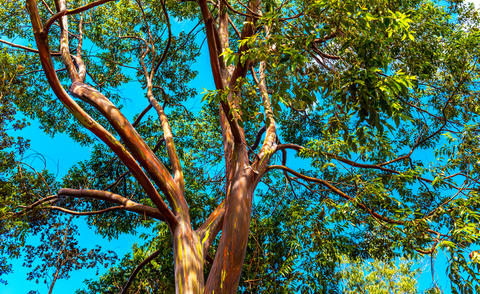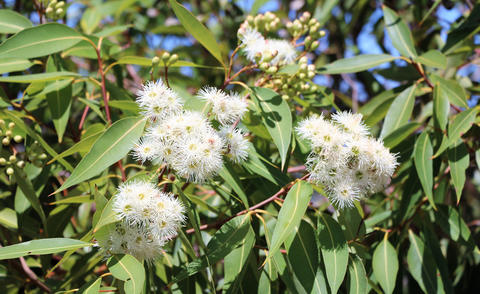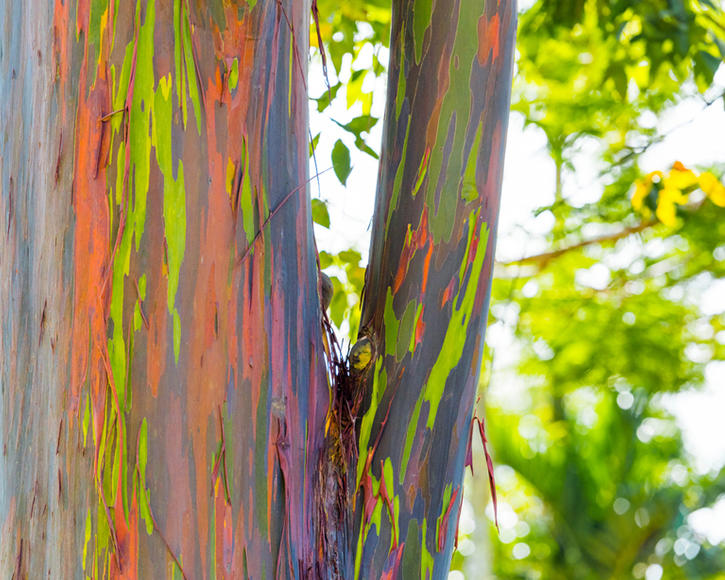Rainbow Eucalyptus
Those who have seen the colorful bark of the rainbow eucalyptus on their travels never forget it. Here are our tips for planting and care.
Factsheet
- Growth type
-
- Main Tree
- Growth height (from)
- from 5000 cm to 6000 cm
- Growth characteristics
-
- upright
- Flower color
-
- white
- Flowering time (month)
-
- January to February
- Flower shape
-
- Bundles
- umbel-like
- Leaf color
-
- green
- page format
-
- ovoid-lanceolate
- full margined
- stalked
- Sheet properties
-
- evergreen
- Fruit shape
-
- Capsule
- Light
-
- sunny
- Soil type
-
- gravelly to sandy
- Soil Moisture
-
- moderately humid to humid
- ph value
-
- weakly acidic to acidic
- Lime compatibility
-
- sensitive to lime
- Nutrient requirements
-
- moderately nutritious
- Humus
-
- low humus
- Decorative or utility value
-
- Bark decoration
- picturesque growth
- Winter Hardness
-
- frost-sensitive
- Use
-
- Interior greening
- Planters
- Winter garden
- Garden style
-
- Pot garden
The Rainbow Eucalyptus (Eucalyptus deglupta) is probably the most impressive member of the genus Eucalyptus from the Myrtaceae family – travelers who have witnessed the tree with its multi-colored trunk in its native tropical regions can scarcely forget it. The Rainbow Eucalyptus was first mentioned in the mid-18th century, as ‘Arbor multicolor’ - so, as “multicolored tree”. Today, it is colloquially know as the Rainbow Gum or Rainbow Eucalyptus.
Unlike most Eucalyptus species, the Rainbow gum doesn’t only grow in Australia, but also in Papua New Guinea, Sulawesi and the Philippines, among other places. It is the only member of its genus which can even be found in the northern hemisphere. It is cultivated on plantations for harvesting wood fiber for paper manufacturing. In non-tropical climates it can only be cultivated in heated rooms with high humidity - provided you can get hold of the tree in the first place. At non-tropical latitudes, only the winter-hardy Cider gum tree (Eucalyptus gunnii) is commercially available.

The Rainbow Eucalyptus grows very quickly and, in the outdoors, develops into 197 foot tall tree, on average, with a trunk diameter of a good 6.6 feet. The aptly named buttress roots extend from the side of the trunk and help anchor it into the soil: This is a characteristic of many tropical trees, which is also found in Elms. The crown shape is initially conical, but becomes flatter with age. Indoors, the tree remains significantly smaller, however under suitable conditions it can also grow to heights of several feet.
The Rainbow Eucalyptus is widely recognized thanks to its bark. This is smooth and essentially brownish. Because tears develop in the bark year on year, the luminous, green bark appears which, before also turning yellowish-brown, displays a color spectrum which ranges from luminous blue and violet to orange and fire red.
The leathery foliage is stalked, full-margined and ovate to lanceolate. The leaves are notably pointed at the front. The leaf blades are bald and shiny.
The umbel-shaped flower clusters of Eucalyptus deglupta can be found on the sides and ends of the shoots. The buds are covered with a small, semi-circle cap, typical for the genus, which falls off when they open but leaves a green scar in the middle of the flower. In non-tropical regions, the flowering period is in the winter months, although flowers on container plants are very rare.
The Rainbow Eucalyptus has round, capsule fruit which contains numerous, tiny brown and winged seeds.
In order to flourish, the Rainbow Eucalyptus requires a humid climate, i.e. a moist, warm environment. In non-tropical regions, only a heated conservatory or a temperate greenhouse can provide this. The location should also be sunny and - in light of the growth - roomy.
Plant the Rainbow Eucalyptus in a lime-free (as far as possible), acidic and thin substrate which is mixed with additional materials such as gravel, expanding clay or coarse sand to that it remains permeable and loose. A drainage layer in the bottom of the pot is also advisable.
The plant is as sensitive to lime in the substrate as it is to lime in irrigation water. Never let the root ball dry out, but only water it with lime-deficient water or rain water.
The Rainbow Eucalyptus enjoys a small amount of liquid fertilizer in a weak dosage between April and September.

The bigger the container, the faster the growth rate of the Eucalyptus deglupta. Therefore, you should select the plant container carefully and re-pot gently due to the sensitive roots.
Due to its growth rate and size, you can’t avoid pruning the plant indoors. The correct time to prune and thin is in the spring..
Eucalyptus deglupta is not winter-hardy and also requires temperatures between 50 and 60 degrees Fahrenheit during the colder times of year. As the species is evergreen, its winter home needs to be light.
Seeds are generally only available online. Seed sowing is done in the spring.. The seeds should take about two to three weeks to germinate at a constant temperature of 68 degrees Fahrenheit and extremely high humidity.
The rainbow eucalyptus has a tendency to develop gray mold in its winter home, which is why the room should be regularly ventilated. Sometimes appear aphids, usually due to migration from neighboring plants.

